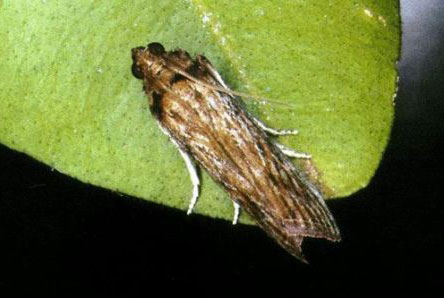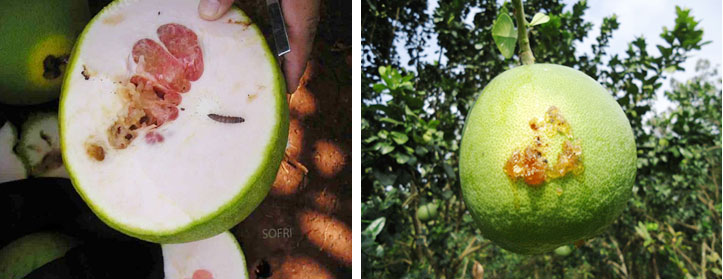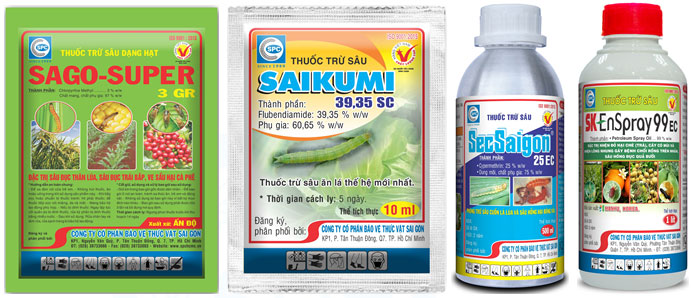|
Prevention Of Borer Of Green Skinned Pomelo
31/07/2021
BSc Kim Xuan Loc Green-skinned pomelo is a fruit tree with high economic value, green-skinned pomelo has greatly improved the lives of many farmers in the Mekong Delta. However, the increasingly complex climate change situation has made diseases and pests increasingly difficult to manage. Among the pests, the pomelo borer is the most worrisome pest because it causes a considerable loss of pomelo yield. I. Morphological characteristics: Pomelo borer has the scientific name Citripestis sagittiferella Family: Pyralidae; Order Lepidoptera. The life cycle of pomelo borer is about 23 - 30 days: Eggs: 4 - 7 days → Larvae: 9 - 15 days → Pupae: 7-10 days → Adult: 2 - 4 days. - Egg stage: Eggs are laid in egg mass on the surface of the fruit skin, newly laid are milky white, red-orange when about to hatch, egg diameter is about 1 mm, each egg mass has from 3 to 10 eggs. - Larval stage: Larva has 4 instars, newly-hatched larva is light yellow, head is black brown, then darkens, the bigger the larva is, the darker the red color is, the larva in last instar is reddish brown. then turns greenish brown before pupating, the body is about 14 - 20 mm long. - Pupation stage: Dark brown pupa, about 10-13 mm long. - Adult stage: Adult has a body length of about 9-12 mm, gray-brown color with yellow-brown to gray-brown fore wings, transparent hind wings. - The adult after coming out of the cocoon for 2-4 days, pair up and lay eggs at night. During the day, the adult usually lie dormant in the foliage. Eggs hatch on the surface of the fruit skin after 4 - 7 days of incubation and 1 - 2 hours after hatching, the young larvae begin to bore and burrow into the fruit to cause harm. When having enough strength , worms spin silk , drop to the ground and pupate in the soil. Fig 3: Larva II. Harmful characteristics: Newly-hatched worms immediately bore into the fruit, eat the fruit skin, then worms get bigger and bore deep inside to eat the pulp of the fruit,they also eat the seeds. Worms bore and eat very quickly, worms eat and excrete feaces to form a layer of sawdust outside the fruit skin according to the bored hole. Infested fruits often see resin secretion, causing the developing fruit to drop prematurely, the mature fruit to rot and may also be dropped before harvest. The worms usually bore from the middle of the fruit to its bottom, and can cause damage at all stages of fruit development from very early on from fruit setting to near harvest fruit. Figure 4: Symptom of pomelo to get bored III. Preventive measures - Regularly prune and destroy all wormed fruit ,including those that fall on the ground to kill worms. - Covering the fruit after fruit setting about a month, combined with pruning some of the poor quality fruits, before the fruit covering , it should be sprayed with pesticides and mineral oil in the whole garden, the effect of fruit covering will be very high. - Create conditions for plants to produce buds and flowers at the same time by pruning branches and reasonable fertilizer regime to increase the health of the tree. - Filling with mud to limit places where worms pupate. It is possible to broadcast SAGO SUPER 3G or GA NOI 4G to kill pupae in the soil. - Use light traps to trap adults. After coming out of the cocoon, females pair up to mate and lay eggs, about 4-7 days after the eggs hatch, so it is recommended to spray after the highest number of adults, about 4 - 7 days later we can use the following products to kill larvae: SECSAIGON 25EC, SAIKUMI 39.35SC....When spraying, you can add SK ENSPRAY 99EC mineral oil to prevent washout and increase the effect of killing worms. |
To prevent, in addition to plowing and burying weed seeds, collecting weed stalks and stumps left after tilling the land to burn, not letting weeds produce seeds in production fields, etc., the use of chemical products is still a measure. optimal because of its ability to thoroughly kill weeds, reduce labor and take advantage of more time than manual weeding.
Miner has the scientific name Phyllocnistis citrella Staint., family Phyllocnistidae, order Lepidoptera. The miner occurs in many countries in the tropics and subtropics. The main host of the miner is the citrus family - Rutaceae. In addition, the miner also attacks mangosteen and some other plants.
Adult is a small planthopper, with a body 2-3 mm long, the whole body is ash gray, slightly greenish, the wings are opaque with many small brown spots.Eggs are oval, 0.3 mm long, have a pointed end and are attached directly to the leaf surface, leaf axils.
Green bugs specialize in the fruit of citrus groups (oranges, tangerines, lemons, grapefruits, kumquats...), some people call them orange bugs, or orange suckers. Their scientific name is Rhynchocoris poseidon or Rhynchocoris humeralis.
In Vietnam, yellow leaf curl disease is very common on papaya trees, especially the disease is often severe in areas of high and continuous planting, areas with hot and arid climates. The disease has significantly reduced the yield and quality of papaya. Gardens that are infected early when the plants are young may not yield. However, up to now, many gardeners still do not know the cause and how to fix it.
Spider mites are common pests on citrus trees, especially in hot and dry climates that are suitable for spiders to grow and cause severe damage.The group of harmful spiders is usually very small in size, unlike the natural enemy spiders.
This group includes species that are generally very small in size, causing damage by sucking plant sap (on leaves, fruits, branches, stems).
There are many species of mealybugs present on the group of Oranges,Tangerines,Grapefruits and Lemons (Citrus), which can be divided into 2 groups:
+ Group of sticky mealybugs with common varieties such as Lepidosaphes, Aonidiella, Coccus and Saissetia.
+ Group of flower mealybugs with common genera and species such as Pseudococcus, Planococcus and Icerya purchasi.
Dry branches and berries disease often appear to be common damage on coffee gardens during the rainy season. The disease causes death of branchs, dry fruit, severely affects the canopy structure and coffee yield if not paid attention to prevention.
Pink disease commonly causes diseases on rubber plantations in the rainy season, especially on garden from 4-8 years old. This year, rubber has to go through a period of severe drought, weakening the tree, so now in tnshe rainy season it is easy to get infected. Therefore, it is necessary to pay attention to good management to avoid affecting the garden.
In recent years, the area of citrus has been expanded because it is a fruit tree with high economic efficiency. However, in order to sell at a high price, not only in quality but consumers also require the external beauty of the fruit, so pest management on citrus is a matter of great concern to farmers. The hot season is a favorable condition for thrips to develop and cause damage, affecting the commercial value of fruit.
- Headquarters
- SAIGON PLANT PROTECTION JOINT STOCK COMPANY
- RQ 1, Nguyen Van Quy St., Tan Thuan Dong Ward, District 7, HCM City
- Tax code: 0300632232
- Tel: (028) 38 733 295 - 38 732 077
- Fax: (028) 38 733 003 - 38 733 391
- Website: www.spchcmc.vn - Email: info@spchcmc.vn
- SAIGON PLANT PROTECTION COMPANY
- SAIGON PLANT PROTECTION JOINT STOCK ENTERPRISE
- Lot C1-C3 Hiep Phuoc Industrial Park, Hiep Phuoc Commune, Nha Be District, HCM City
- Tel: (028) 3873 4089 - Fax: (028) 3873 4090
- Affiliated Unit
-
- Quick Links
- Home
- About us
- Career Opportunities















